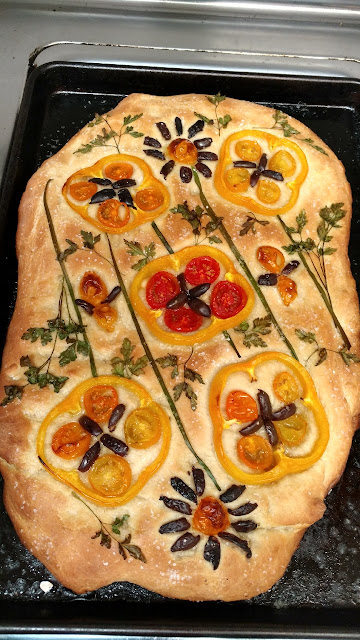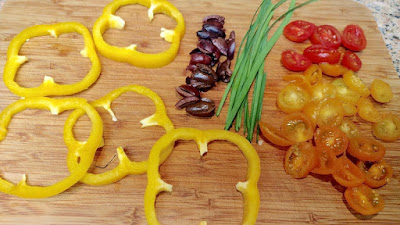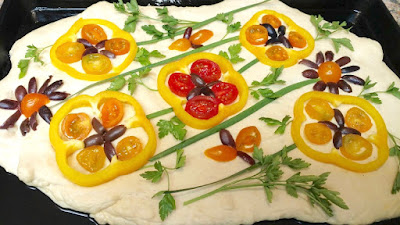
Recipe: Garden-variety focaccia decorated with whimsy
 |
|
The finished product: Edible art.
(Photos: Debbie Arrington) |
It's OK to play with your food, especially when making focaccia.
This simple Italian flatbread can be a blank canvas for garden-inspired edible "art." Use cut vegetables, tomatoes and herbs as your "paint."
Using sliced peppers, tomato, onions and more, create geometric designs or whimsical flowers. Clusters of sliced cherry tomatoes can become bouquets of appetizing blooms.
Slice toppings about 1/8- to 1/4-inch thick. Dip parsley or cilantro in lemon juice mixed with water, so those leaves will retain their green color during baking.
Then, have fun. Garden-variety focaccia is something the whole family can help create.
A bread machine speeds up the dough-making process. The actual baking takes less than 25 minutes.
Too hot to turn on the oven? This focaccia can be "baked" on the grill.
Garden-variety focaccia
Makes one large loaf
Ingredients:
 |
| Use a variety of vegetables to "paint" a picture. |
 |
|
Satisfied with the picture? Brush with olive oil, sprinkle
with salt, and pop it in the oven.
|
Comments
0 comments have been posted.Sacramento Digs Gardening to your inbox.
Food in My Back Yard Series
May 6: Maintain soil moisture with mulch for garden success
April 29: What's (already) wrong with my tomato plants?
April 22: Should you stock up on fertilizer? (Yes!)
April 15: Grow culinary herbs in containers
April 8: When to plant summer vegetables
April 1: Don't be fooled by these garden myths
March 25: Fertilizer tips: How to 'feed' your vegetables for healthy growth
March 18: Time to give vegetable seedlings some more space
March 11: Ways to win the fight against weeds
March 4: Potatoes from the garden
Feb. 25: Plant a fruit tree now -- for later
Feb. 18: How to squeeze more food into less space
Feb. 11: When to plant? Consider staggering your transplants
Feb. 4: Starting in seed starting
Sites We Like
Garden Checklist for week of May 11
Make the most of the lower temperatures early in the week. We’ll be back in the 80s by Thursday.
* Plant, plant, plant! It’s prime planting season in the Sacramento area. Time to set out those tomato transplants along with peppers and eggplants. Pinch off any flowers on new transplants to make them concentrate on establishing roots instead of setting premature fruit.
* Direct-seed melons, cucumbers, summer squash, corn, radishes, pumpkins and annual herbs such as basil.
* Harvest cabbage, lettuce, peas and green onions.
* In the flower garden, direct-seed sunflowers, cosmos, salvia, zinnias, marigolds, celosia and asters. (You also can transplant seedlings for many of the same flowers.)
* Plant dahlia tubers.
* Transplant petunias, marigolds and perennial flowers such as astilbe, columbine, coneflowers, coreopsis, dahlias, rudbeckia and verbena.
* Keep an eye out for slugs, snails, earwigs and aphids that want to dine on tender new growth.
* Feed summer bloomers with a balanced fertilizer.
* For continued bloom, cut off spent flowers on roses as well as other flowering plants.
* Add mulch to the garden to maintain moisture. Mulch also cuts down on weeds. But don’t let it mound around the stems or trunks of trees or shrubs. Leave about a 6-inch-to-1-foot circle to avoid crown rot or other problems.
* Remember to weed! Pull those nasties before they set seed.
* Water early in the day and keep seedlings evenly moist.